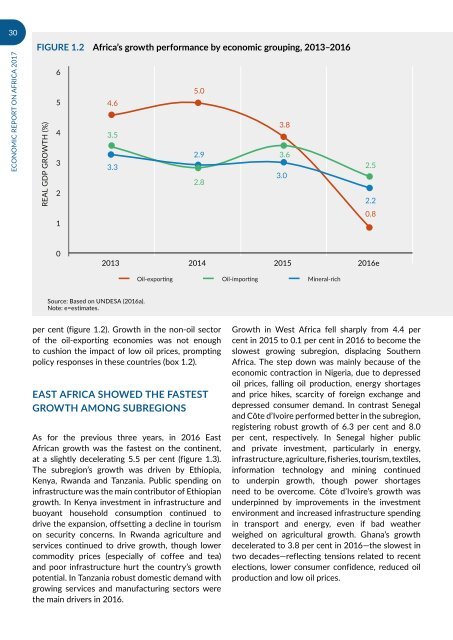URBANIZATION AND INDUSTRIALIZATION
Economic%20Report%20on%20Africa%202017%20UNECA
Economic%20Report%20on%20Africa%202017%20UNECA
You also want an ePaper? Increase the reach of your titles
YUMPU automatically turns print PDFs into web optimized ePapers that Google loves.
30<br />
ECONOMIC REPORT ON AFRICA 2017<br />
Figure 1.2 Africa’s growth performance by economic grouping, 2013–2016<br />
REAL GDP GROWTH (%)<br />
6<br />
5.0<br />
5<br />
4.6<br />
3.8<br />
4<br />
3.5<br />
2.9<br />
3.6<br />
3<br />
3.3<br />
3.0<br />
2.8<br />
2<br />
1<br />
2.5<br />
2.2<br />
0.8<br />
0<br />
2013 2014 2015 2016e<br />
Oil-exporting Oil-importing Mineral-rich<br />
Source: Based on UNDESA (2016a).<br />
Note: e=estimates.<br />
per cent (figure 1.2). Growth in the non-oil sector<br />
of the oil-exporting economies was not enough<br />
to cushion the impact of low oil prices, prompting<br />
policy responses in these countries (box 1.2).<br />
EAST AFRICA SHOWED THE FASTEST<br />
GROWTH AMONG SUBREGIONS<br />
As for the previous three years, in 2016 East<br />
African growth was the fastest on the continent,<br />
at a slightly decelerating 5.5 per cent (figure 1.3).<br />
The subregion’s growth was driven by Ethiopia,<br />
Kenya, Rwanda and Tanzania. Public spending on<br />
infrastructure was the main contributor of Ethiopian<br />
growth. In Kenya investment in infrastructure and<br />
buoyant household consumption continued to<br />
drive the expansion, offsetting a decline in tourism<br />
on security concerns. In Rwanda agriculture and<br />
services continued to drive growth, though lower<br />
commodity prices (especially of coffee and tea)<br />
and poor infrastructure hurt the country’s growth<br />
potential. In Tanzania robust domestic demand with<br />
growing services and manufacturing sectors were<br />
the main drivers in 2016.<br />
Growth in West Africa fell sharply from 4.4 per<br />
cent in 2015 to 0.1 per cent in 2016 to become the<br />
slowest growing subregion, displacing Southern<br />
Africa. The step down was mainly because of the<br />
economic contraction in Nigeria, due to depressed<br />
oil prices, falling oil production, energy shortages<br />
and price hikes, scarcity of foreign exchange and<br />
depressed consumer demand. In contrast Senegal<br />
and Côte d’Ivoire performed better in the subregion,<br />
registering robust growth of 6.3 per cent and 8.0<br />
per cent, respectively. In Senegal higher public<br />
and private investment, particularly in energy,<br />
infrastructure, agriculture, fisheries, tourism, textiles,<br />
information technology and mining continued<br />
to underpin growth, though power shortages<br />
need to be overcome. Côte d’Ivoire’s growth was<br />
underpinned by improvements in the investment<br />
environment and increased infrastructure spending<br />
in transport and energy, even if bad weather<br />
weighed on agricultural growth. Ghana’s growth<br />
decelerated to 3.8 per cent in 2016—the slowest in<br />
two decades—reflecting tensions related to recent<br />
elections, lower consumer confidence, reduced oil<br />
production and low oil prices.


